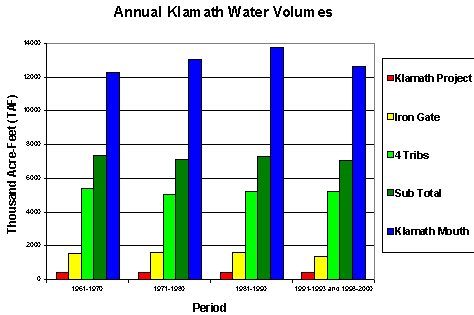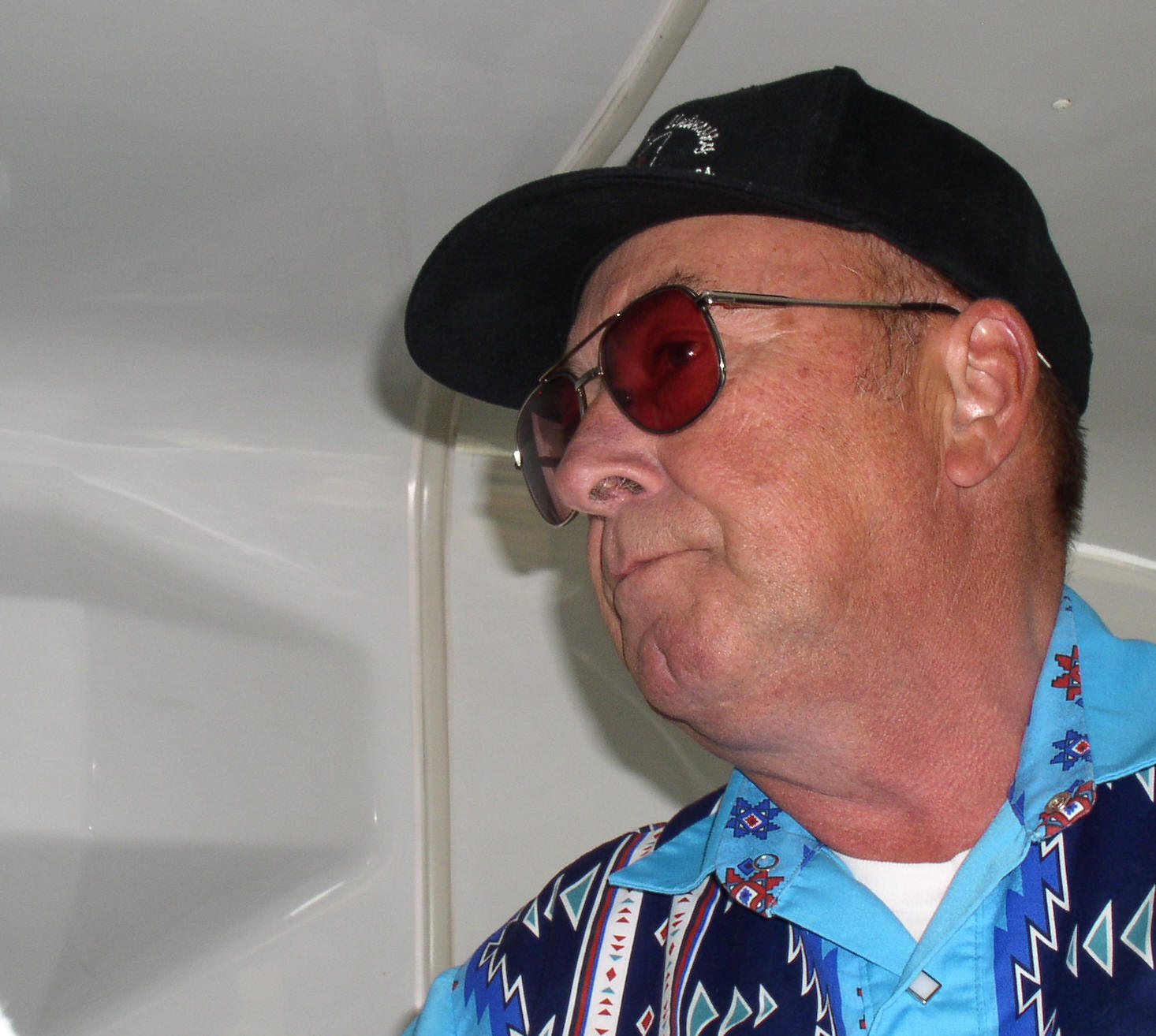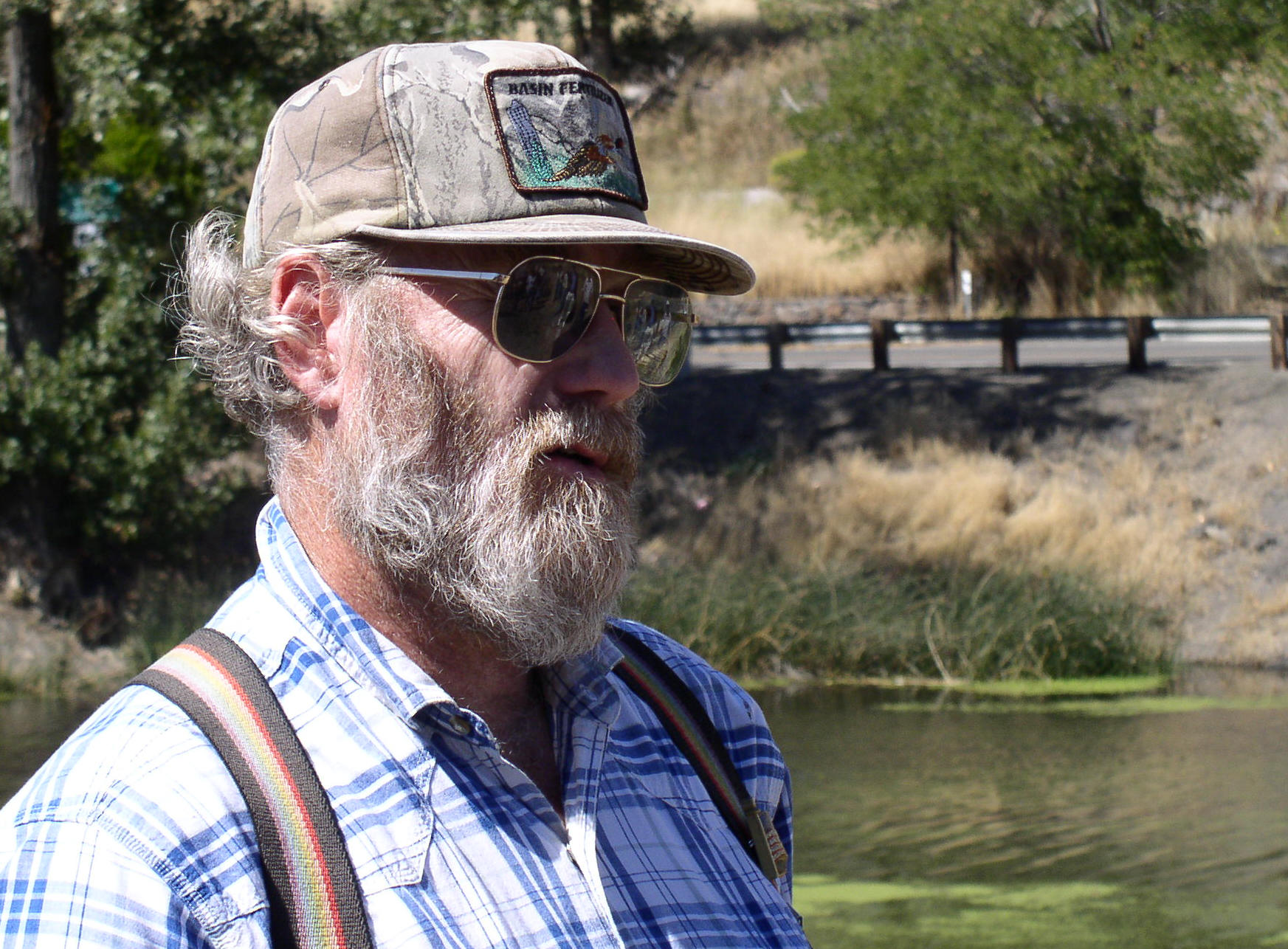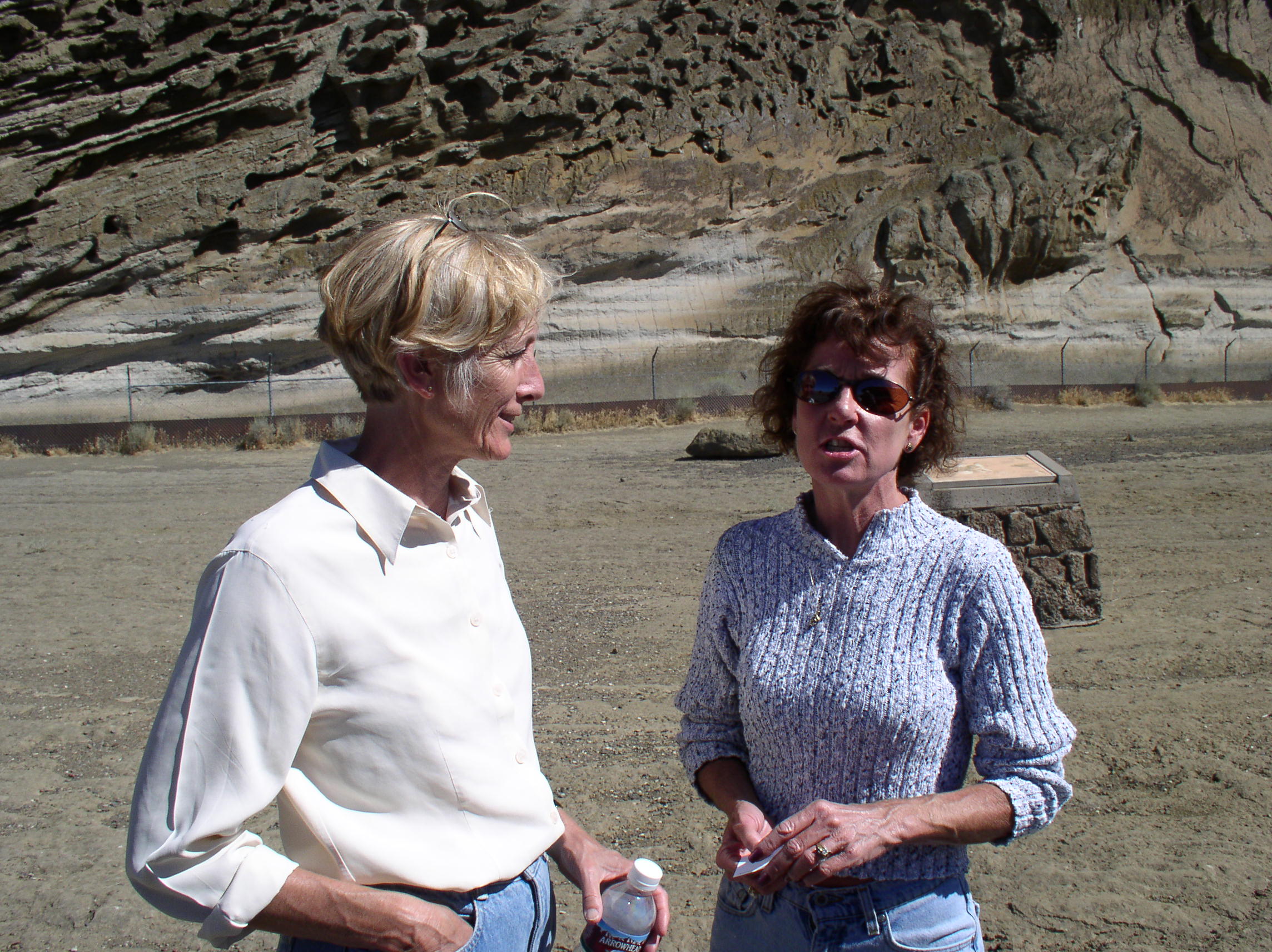| Nearly 30 people
met at the BOR headquarters to hear
presentations about the Klamath Project.
Alice Kilham, from the Klamath River Compact
Commission, organized the tour, and Christine
Karas, BOR, facilitated the event.
Bob Davis,
Klamath BOR, explained fish and water monitoring
and research, and he identified how
many $millions are being spent in those efforts. He said that a
study group of irrigators, gov't agencies,
tribes and other groups reached a consensus
determining that the Chiloquin Dam should be
removed. According to USFWS studies, the
dam blocks 95% of upstream habitat. (it
should be noted that actually COUNTING the fish
has not been funded by the DOI--if the fish get
counted and there are too many, they would have
to delist, thereby losing control of irrigator's
water--KBC).
Cecil Leslie, BOR, explained, "The basin was
full of water, and the water was not going
downstream at that time. This area,
through evapotransporation, used between 3 and 4
AF /acre per year. When asked, "if you had
it to do all over again, what would you do?"
regarding the Klamath Project, Leslie responded,
"I'd do exactly the same thing......I think
we've done a good job in this basin.
Agriculture used less water than the basin used
before. The water that's being delivered
downstream is more than was in the downstream
system previous to the project....we have photos
of a couple of years that show that Link River
went dry between Upper Klamath Lake, and Lake
Ewana would go dry during the summer months."
Bob Gearheart, HUS Professor in environmental
resources engineering, and director of the
Klamath Wateshed Institute,
offered to get a grant to handle all of the data
and form a website, and Oregon Institute of
Technology President Martha Ann Dow, said they
are already in the process of archiving this data
in a data base in collaboration with OSU. Dan Keppen,
Klamath Water Users Executive Director,
expressed appreciation for Humbolt's offer but
said that he felt Klamath Basin data should not
be controlled outside of our basin...there are
many qualified experts here.
Christine Karas, BOR Deputy Area Manager,
described how they plan to bring together all of
the entities who are trying to control water and
restoration in the Klamath Basin. She also said
"the DOI office of policy is working with the
tribes to try to develop a water rights
settlement..." .Karas said that there are many
groups hoping to return the Klamath Basin to its
prehistoric condition, and that is not
going to happen...."we are here".
Mike Green, BOR manager of the lease lands,
showed a map of the 21,000 irrigated acres of
refuge lease land. This is the largest
irrigated refuge farm program in America. He described how they are flooding
areas which reduces soil-borne pests, decreasing
the need of pesticides. He and Bob David stated that very few
pesticides allowed on the lease lands, and there have
been no negative impacts to fish, waterfowl or
wildlife.
In response to a question by Rollin Richmond,
Humboldt State University President, Bob Davis
stated that there are $8 million derived from
agriculture in the local community annually, $2
million going to the U.S. government.
Mike Green continued by explaining the Kuchal
Act of Congress, tying agriculture and wildlife
together forever. He explained that
presently only 13% is in row crops. A
4-year study of wildlife and crops determined
that there is more dark goose use in potatoes than in
the grains.
Dr Harry Carlson, Superintendent,
Intermountain Research and Extension Center from
Tulelake, said that the Kuchel Act was a
compromise regarding homesteading and wildlife.
It was intended to be homesteaded, but rather
ended in legislation that allowed farming
forever, with exceptional benefits for wildlife.
It is a huge feed source for birds. He
said that "some groups don't want to see a
combine in the refuge---it isn't aesthetic."
(farms supply 70 million lbs of food for
waterfowl per year...for more (audio)
info go
HERE.
According to a
USFWS representative, 15-20 million birds
annually come to the refuges: 80% of the
waterfowl pass through our refuges, and 50%
stop in the Klamath Refuge. This is the
largest bald eagle gathering in the lower 48
states. He said that refuges get reused farm
water, so when the water is cut off to the
farms, it depletes the refuges and drys up some
marshes, destroying certain wildlife feeds and
habitat. "it's hard to maintain marshes with
this sporadic delivery to the farms."
With the current change of priorities
(single-species management), it's a challenge to
manage the refuges.
It is the
most efficient project in the United States,
water is reused 7 times, and the return flows
keep the refuges supplied with water that,
contrary to environmental groups' and the
media's best efforts to advertise otherwise, the
agricultural water is not contaminated. No
adverse impacts have been found..
Karas expressed
the need for water certainty for farms and
refuges.
Dan Keppen
explained the tour route, conservation measures
taken by irrigators, and also the need for
certainty for farms and refuges.
We first toured
the A Canal, $15 million fish screen, seeing the
complete process of screening sucker fish so
they won't swim down the Canals. This
structure was built in 8 months.
 |

Dr. Ken Rykbost,
Superintendent, OSU-
Klamath County
Experiment Station |
In route on tour
bus to Lost River, Dr Ken Rykbost presented his
hydrology report. He explained how the Klamath
Project consists of only 3.4% of the water at
the mouth of the Klamath River. His
research of the Hardy Flow study discovered that
Dr Hardy used a time period of the highest
precipitation and river flows in recorded
history to develop demands on Klamath
Project.stored water. For full Power Point, go
HERE.
|

Bruce McCoy |
Manager of the Horsefly
Irrigation District, Bruce McCoy Bruce
described how the irrigation system works in
that area of the project, with the
connection between Lost River and the
Klamath River. |
The tour
proceeded through Shasta View, Horsefly, and
Malin Irrigation districts, with Harold Hartman,
Malin Irrigation District, explaining the
irrigation systems, one being entirely
pressurized. He pointed out the TID wells
on Stateline, telling how over 200 domestic and
irrigation wells went dry in 2001 with our
irrigation water being withheld from the
ditches, and the TID wells were pumping massive
amounts of groundwater. This year TID was
forced to pump their wells (or else the BOR
would shut down the Klamath Project), but there
was less 3rd party impacts because the
ditches were full.
The DOI demanded
that we downsize the Klamath Project this year
by forming a 'water bank', where the farmers
were paid to not farm, or paid to irrigate with
private wells. We saw many parched fields.
When land is idled, there are diminished return
flows, meaning that less
water goes to the refuge and down the Klamath
River. This is greatly harming our local
economy and the delicate balance of water in our
entire ecosystem.
|
Hartman and
John Crawford, TID, told how the water used
to be quite deep throughout the Tulelake
Basin. It was not primarily wetlands
like many agencies and groups have portrayed,
and the water line was pointed out on the Petroglyphs, approximately 20' deep.
Crawford told how the valley was comprised
of WWI and WWII veterans, who won homesteads
after their service in the wars. This
was a drained lake bed, with few roads and
no infrastructure..they built the entire
community.
In Coppock Bay,
at the SE edge of the basin, Crawford showed
the ditch lining project, located where water
had been
lost to ground absorption. In many
places this would be counterproductive
because the lack of water in ditches would
dry up shallow wells. Many
conservation practices were shown.
Last week KWUA won a conservation award from
Oregon State for it's exceptional efforts in
water conservation. |

Midge Thierolf, Senator
Wyden's S. Oregon Rep, and Deb Crisp,
Tulelake Growers Assoc executive director, at Petroglyphs |

Dr Harry Carlson speaks
regarding the refuges |
Crawford, Crisp and Carlson
spoke throughout the tour of the refuges,
explaining benefits to waterfowl and
wildlife from agriculture on the refuge
lease lands. Flood/fallow program was shown, where
farmland is flooded, and flooded land is
farmed, also with great benefits for both farms
and wildlife. Hundreds of birds were
viewed from the bus. |
We saw where the D Plant is the pumping
plant built and 6.600 foot concrete-lined tunnel
which conveys drainage water from Tule Lake
sumps to the Lower Klamath National Wildlife
Refuge. Historically this was a closed
basin...this water did not go into the Klamath
Lake, so a tunnel was built through Sheepy Ridge to allow the lake to
be drained and land to be farmed. So now
Klamath Lake and River flows are higher than
historic levels.
We drove through Lower Klamath Refuge, and
back to Klamath BOR office to end the tour.
These tours provide invaluable education and
interaction between all those concerned with
Klamath Basin issues.
|

